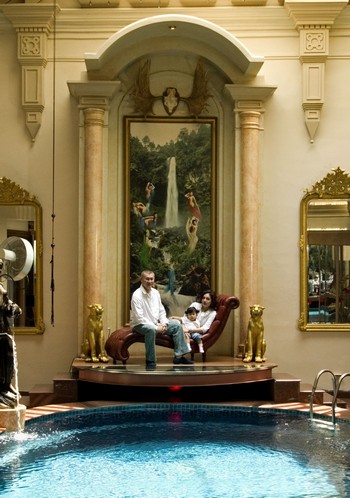Gerry van Klinken
Indonesian opulence: The 62-year old lawyer Warsito Sanyoto and hisfamily. See story by Ben KnapenAhmad “deNy” Salman (reachdeny@gmail.com) |
We first wanted to take a look at how they live as human beings. Deasy Simanjuntak's light-hearted story about wedding preparations might ring bells with anyone who shares family with social climbers. Ben Knapen’s peek into the home of an ostentatiously wealthy lawyer – beautifully illustrated by Ahmad deNy Salman – puts on display an entire class of new money. Some of their lifestyle excesses produce serious health hazards, as Madarina Julia shows in her piece on the growing childhood obesity epidemic.
Secondly we wanted to find out how they made their money. The overwhelming impression is that good political connections are a must for any aspiring tycoon in Indonesia. Akiko Morishita’s portrait of a Kalimantan timber baron is a fabulous example, which incidentally also shows that you do not have to leave the provinces to get rich. When it comes to paying taxes, the rich get an easy ride from officials. Indonesia Corruption Watch advisor Yanuar Rizky explains to Simon Butt in detail how this is done. However, not all our authors agreed connections are still essential. Christian Chua argues that the ease with which many Chinese tycoons survived the fall of Suharto proves that their money alone is enough protection in today’s rampant capitalism.
Thirdly we stood back and put the rich back into their Indonesian context. Christian von Luebke demonstrates that Indonesia is a much more unequal society than official statistics have long pretended. It might be as unequal as China, which is now experiencing serious tensions as a result. Gary Gartenberg discovers the cultural roots of these tensions in a place millions of Indonesians still love but few outsiders bother to read – the martial artscomic strip of the pre-electronic era. Much about this stereotypical image of rich villains is unfair, of course. We would have loved an article on one of the wealthy but selfless patrons of the arts for example, but couldn’t manage it. Nevertheless, that the gap between rich and poor is bad for Indonesia remains a basic truth. No one could make that clearer than Jeffrey Winters, in his powerful lead article entitled ‘Who will tame the oligarchs?’
As always, a word of thanks to all our contributors, illustrators, editors, reviewers, proofreaders, committee members, webmaster, and other workers, most behind the scenes. Believe it or not, each one is a volunteer. I hope you enjoy what we have produced.
Gerry van Klinken (klinken@kitlv.nl) is this edition’s guest editor. He is a senior researcher at the Royal Netherlands Institute of Southeast Asian and Caribbean Studies (KITLV) in Leiden.
